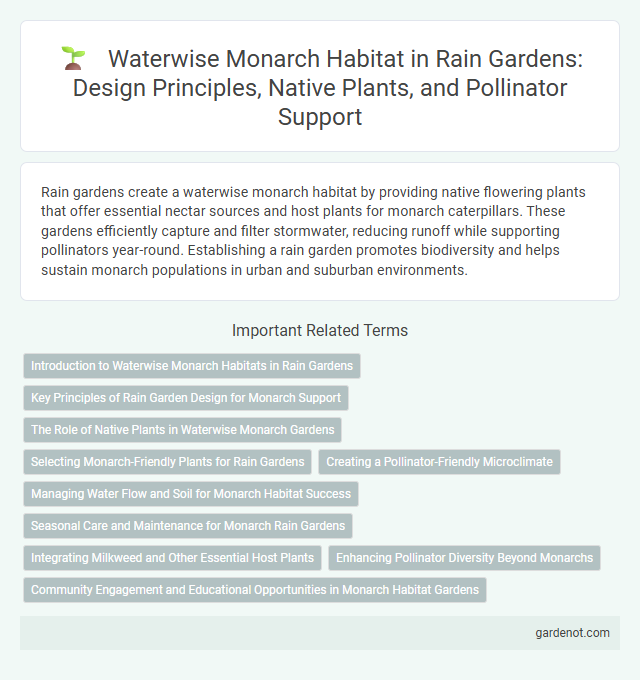Rain gardens create a waterwise monarch habitat by providing native flowering plants that offer essential nectar sources and host plants for monarch caterpillars. These gardens efficiently capture and filter stormwater, reducing runoff while supporting pollinators year-round. Establishing a rain garden promotes biodiversity and helps sustain monarch populations in urban and suburban environments.
Introduction to Waterwise Monarch Habitats in Rain Gardens
Rain gardens designed as Waterwise monarch habitats create essential environments that support monarch butterfly populations while conserving water. These habitats incorporate native, drought-tolerant plants that provide nectar sources and breeding grounds, promoting monarch lifecycle resilience. Integrating rain gardens with water-efficient landscaping techniques enhances urban biodiversity and reduces stormwater runoff.
Key Principles of Rain Garden Design for Monarch Support
Rain gardens designed for Waterwise monarch habitat emphasize native milkweed planting to provide essential breeding and feeding grounds. Incorporating porous soil media and strategic rainwater capture promotes efficient water absorption, reducing runoff while supporting monarch nectar sources. Proper placement in full to partial sun ensures optimal growth of monarch host plants and encourages butterfly activity.
The Role of Native Plants in Waterwise Monarch Gardens
Native plants play a crucial role in Waterwise monarch gardens by providing essential nectar sources and larval host plants that support monarch butterfly life cycles while conserving water. These drought-tolerant species are adapted to local climate conditions, reducing irrigation needs and promoting sustainable habitat restoration. Incorporating native plants enhances biodiversity, improves soil health, and creates resilient ecosystems that benefit monarch populations and other pollinators.
Selecting Monarch-Friendly Plants for Rain Gardens
Selecting monarch-friendly plants for rain gardens enhances waterwise habitats by supporting monarch butterflies with native nectar sources like purple coneflower, milkweed, and butterfly weed. These drought-tolerant species thrive in rain garden conditions, promoting pollinator health while efficiently managing stormwater runoff. Incorporating diverse native flora optimizes habitat resilience and contributes to monarch conservation efforts.
Creating a Pollinator-Friendly Microclimate
Designing a waterwise monarch habitat enhances pollinator-friendly microclimates by incorporating native plants that retain moisture and attract butterflies. Using drought-tolerant species ensures efficient water use while providing essential nectar sources and shelter for monarchs and other pollinators. Strategic placement of shallow water features and shaded areas supports diverse pollinator activity and biodiversity within the rain garden.
Managing Water Flow and Soil for Monarch Habitat Success
Rain gardens designed as waterwise monarch habitats optimize water flow by directing runoff into native, moisture-retentive soils that support milkweed growth crucial for monarch larvae. Effective soil management includes incorporating sandy loam mixed with organic matter to enhance drainage while retaining sufficient moisture, preventing root rot and ensuring nutrient availability. Careful grading and mulching techniques control erosion and water distribution, creating a stable environment that maximizes monarch reproduction and survival rates.
Seasonal Care and Maintenance for Monarch Rain Gardens
Seasonal care of a Waterwise monarch rain garden involves regular monitoring of soil moisture to ensure optimal hydration for native milkweed and nectar plants, crucial for monarch butterfly larvae and adults. Pruning dead stems in late winter encourages healthy new growth, while removing invasive species prevents competition and maintains habitat quality. Mulching in spring retains moisture and suppresses weeds, supporting a sustainable environment for monarch populations throughout the year.
Integrating Milkweed and Other Essential Host Plants
Creating a waterwise monarch habitat involves integrating milkweed and other essential host plants that thrive in rain gardens to support monarch butterfly populations. Milkweed species like Asclepias syriaca and Asclepias tuberosa provide crucial breeding grounds and nourishment for monarch larvae, while native nectar plants such as coneflowers and goldenrod offer sustained food sources for adult butterflies. Rain gardens designed with these moisture-tolerant, pollinator-friendly plants enhance water management and biodiversity by filtering runoff and attracting diverse wildlife.
Enhancing Pollinator Diversity Beyond Monarchs
Waterwise rain gardens create a thriving monarch habitat while supporting a diverse array of pollinators such as bees, butterflies, and hummingbirds. Strategic planting of native flowers and nectar-rich plants like milkweed, coneflowers, and goldenrod fosters year-round food sources and shelter for various pollinator species. Enhancing pollinator diversity beyond monarchs contributes to ecosystem resilience and promotes healthy, sustainable urban and suburban environments.
Community Engagement and Educational Opportunities in Monarch Habitat Gardens
Monarch habitat gardens designed with rain garden principles foster community engagement by involving local residents in planting native flora that supports monarch butterflies. These gardens serve as outdoor classrooms, offering educational opportunities on waterwise gardening practices, pollinator biology, and sustainable landscape management. Collaborative workshops and citizen science projects enhance awareness and stewardship, promoting biodiversity and conservation within urban and suburban environments.
Waterwise monarch habitat Infographic

 gardenot.com
gardenot.com